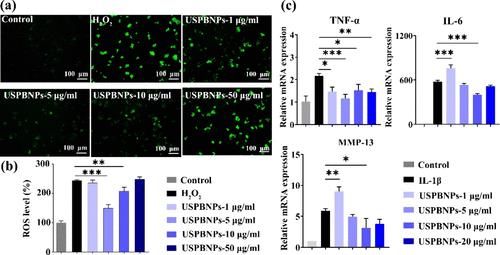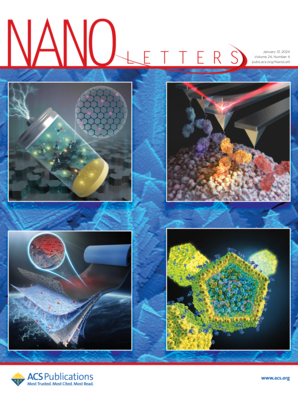Correction to “Ultrasmall Prussian Blue Nanozyme Attenuates Osteoarthritis by Scavenging Reactive Oxygen Species and Regulating Macrophage Phenotype”
IF 9.6
1区 材料科学
Q1 CHEMISTRY, MULTIDISCIPLINARY
引用次数: 0
Abstract
The authors regret that the fluorescence microscopy images of intracellular ROS in the H2O2 group and USPBNPs-1 μg/mL group in Figure 3a were used with a mistake. The corrected images in the H2O2 group and USPBNPs-1 μg/mL group in Figure 3a are shown below. This figure mainly showed the scavenging efficiency of a series of concentrations of USPBNPs on intracellular ROS, which was used to screen out the optimal concentration of nanozyme. According to the results of fluorescence microscopy (Figure 3a) and flow cytometry (Figure 3b), the optimal concentration was confirmed to be 5–10 μg/mL. Therefore, the replacement of this image does not affect the conclusion in the paper. Figure 3. Effect of USPBNPs on ROS and inflammatory factors. The scavenging efficiency of USPBNPs on intracellular ROS examined by fluorescence microscopy (a) and flow cytometry (b), *p < 0.05, compared with the H2O2 group. (c) mRNA expression levels of IL-6, TNF-α, and MMP-13. The results are expressed as means ± SD (n = 3). *p < 0.05, **p < 0.01, ***p < 0.005. This article has not yet been cited by other publications.

求助全文
约1分钟内获得全文
求助全文
来源期刊

Nano Letters
工程技术-材料科学:综合
CiteScore
16.80
自引率
2.80%
发文量
1182
审稿时长
1.4 months
期刊介绍:
Nano Letters serves as a dynamic platform for promptly disseminating original results in fundamental, applied, and emerging research across all facets of nanoscience and nanotechnology. A pivotal criterion for inclusion within Nano Letters is the convergence of at least two different areas or disciplines, ensuring a rich interdisciplinary scope. The journal is dedicated to fostering exploration in diverse areas, including:
- Experimental and theoretical findings on physical, chemical, and biological phenomena at the nanoscale
- Synthesis, characterization, and processing of organic, inorganic, polymer, and hybrid nanomaterials through physical, chemical, and biological methodologies
- Modeling and simulation of synthetic, assembly, and interaction processes
- Realization of integrated nanostructures and nano-engineered devices exhibiting advanced performance
- Applications of nanoscale materials in living and environmental systems
Nano Letters is committed to advancing and showcasing groundbreaking research that intersects various domains, fostering innovation and collaboration in the ever-evolving field of nanoscience and nanotechnology.
 求助内容:
求助内容: 应助结果提醒方式:
应助结果提醒方式:


